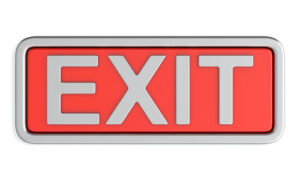Owners don’t like the “Exit” word. They tell us regularly to change it, or that talking about it is uncomfortable. It’s the elephant in the room.
I understand. Anyone selling life insurance or funeral pre-planning knows that you don’t start with “So, let’s discuss what happens when you DIE.” For business owners, leaving the business is like a little bit of death. That’s why black humor in the exit planning world goes like this. “There are seven ways to exit your business. Six of those are head first.”
 Your company has been the central focus of your life for twenty or thirty years, and perhaps more. It is so ingrained in your persona, your self-identification, that it’s frightening to think of that part of your identity disappearing.
Your company has been the central focus of your life for twenty or thirty years, and perhaps more. It is so ingrained in your persona, your self-identification, that it’s frightening to think of that part of your identity disappearing.
Who is Bob?
When Bob leaves home every day to run Bob’s Widgets, he assumes the superhero cape of the owner. He walks in the door of the business as the head honcho, el hefe, the final word, the boss. That cape never comes off. The employees might go out for a beer after work, but he never becomes just one of the guys (especially when the table check comes.) The employees are careful about what they say around him, and he self-censures his conversations with them.
Just as importantly, that cape is always present in his personal life. He is Bob, the owner of Bob’s Widgets, everywhere he goes. At the kids’ sporting activities he is asked to sponsor (“It would be good for your business!”) In his church, at the Chamber of Commerce, and at parties he is introduced as “Bob, the owner of Bob’s Widgets.”
He overhears the identification at family gatherings. “Oh, that’s Sally’s cousin Bob. He owns his own business.” When his friends discuss their jobs, a bad boss, pending layoffs, or a reorganization they say “Of course you don’t have to worry about these things, Bob. You own the company.” (Ah, if they only knew…)
The “Exit” Word
So the word “exit” has a finality that jars a lot of clients. Advisors use lots of alternatives, like transition, succession or continuation – all of which imply an ongoing process, albeit one that doesn’t include you. Why would an advisor use the term “Exit” at all if it could be avoided?
We face up to it because it’s the elephant in the room. I am an Exit Planner. My company sells Exit Planning tools to advisors. We conduct the annual National Exit Planners Survey™. Our ExitMap® suite of coaching tools uses that word on virtually every page.
sells Exit Planning tools to advisors. We conduct the annual National Exit Planners Survey™. Our ExitMap® suite of coaching tools uses that word on virtually every page.
We use it because a coach is a trusted advisor, and a trusted advisor always speaks the truth. Not some of the time. Not just when it is agreeable. Not when it can’t be avoided. All of the time. The coaching relationship should be comfortable, but not too comfortable. Introducing a bit of unease to reinforce a point is part of the job.
I use the “exit” word to describe the final outcome of an implemented business plan. It usually involves a transaction, with legal documentation of a sale or other transfer mechanism. It can also include detailed succession planning for family members or a management team. We often discuss continuation – what happens if the plan is accelerated by unfortunate circumstances. Retirement might have a place in the conversation, or it might be about designing a “second act” or pursuing your life’s passion.
But all those terms, whether synonyms or euphemisms, are encompassed in the “exit” word, We might as well get that on the table from the outset. If you start the advisory process by ducking anything that a client finds uncomfortable, you aren’t serving your purpose as a coach.
Let’s be Honest
Let’s agree to call a business transition what it is. Whether an owner wants to sell the business to a third party, create a family legacy through his or her children, finance a leveraged buy-out to employees, or just close down in an orderly manner, the ultimate objective is to exit.
John F. Dini develops transition and succession strategies that allow business owners to exit their companies on their own schedule, with the proceeds they seek and complete control over the process. He takes a coaching approach to client engagements, focusing on helping owners of companies with $1M to $250M in revenue achieve both their desired lifestyles and legacies.


 Every time an employee asks, “What should I do about this, boss?” there is a little rush. It’s like an old cartoon. The good angel is sitting on one shoulder saying “Make them go through the thought process themselves.” The little horned devil is on the other shoulder saying “Go ahead. Tell him just this once. It’s faster, and it feels good.”
Every time an employee asks, “What should I do about this, boss?” there is a little rush. It’s like an old cartoon. The good angel is sitting on one shoulder saying “Make them go through the thought process themselves.” The little horned devil is on the other shoulder saying “Go ahead. Tell him just this once. It’s faster, and it feels good.” Often, an NQDC is funded by an insurance policy with a death benefit and an increasing cash value. It is owned by the company, which pays the premiums. At retirement, the employee receives the paid-up policy. This approach has the added benefit of lending confidence to the process, as the employee can see the funding and growth of the future benefit.
Often, an NQDC is funded by an insurance policy with a death benefit and an increasing cash value. It is owned by the company, which pays the premiums. At retirement, the employee receives the paid-up policy. This approach has the added benefit of lending confidence to the process, as the employee can see the funding and growth of the future benefit.